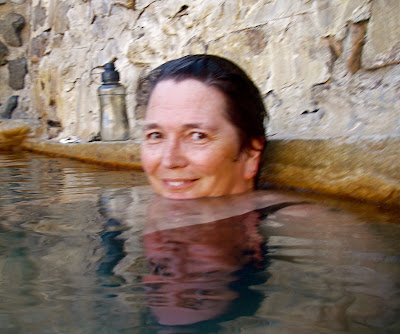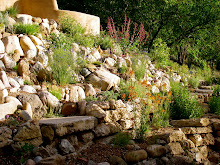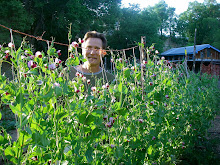
After having published numerous entries here about gardening, I thought it might be about time to tell how I came to this passion. I grew up in the San Francisco Bay Area, and went to college at UC Santa Cruz, majoring in art. On the campus I discovered the wonderful student gardens established by Alan Chadwick, the respected English gardener who introduced raised-bed French-intensive gardening to the United States. I was inspired to plant my first veggie garden in the back yard of the house I rented with friends while I went to school. The rich Santa Cruz soil rewarded me with bountiful yields in spite of my lack of knowledge, and so I was encouraged to continue gardening.
I first met my husband Steve in Santa Cruz, California in 1974, while we were both living at a communal household called "The Farm". The old Ohio-style house sat on five acres of the most delicious black topsoil imaginable. It was owned by a disciple of Alan Chadwick, who saw it as a kind of "Five Acres and Independence" scenario. I had moved there after returning from a six month sojourn in Guatemala, where I lived among impoverished indigenous Mayans eking out a living in a steep mountain valley. After seeing first-hand how important gardening really was, I was determined to learn back-to-the-land skills. When I saw Steve single-handedly clear the land of thorny blackberries to open up space for a vegetable garden, I was impressed. Once we had danced together our future was set!

This is a photo of The Farm taken this past winter. It was considerably funkier when we lived there! We know many devoted organic gardeners who honed their skills on this site, including Dahlia, the intrepid veggie gardener at LQ (seen below on her last birthday).
By the fall of 1976, Steve had taken me back east to "see snow". We had the good fortune when we first arrived in upstate New York to encounter a group who had purchased 432 acres of south-facing hillside near the hamlet of Truxton, in Cortland County. They intended to create a community land trust on the land. Today Common Place Community Land Trust continues to be home to 23 adults and 8 children in 14 homes, but we were the first.
The winter of '76-'77 was the worst in 100 years, and we spent it in the old farmhouse on the land. It had been abandoned in the midst of renovations ten years earlier. There was no insulation, tarpaper siding...and only a wood cookstove for heat. We stayed warm by cross country skiing during the days, and slept under ten wool blankets! Each morning we had to clear 4 to 6 inches of snow off the plank that covered our open air toilet. It snowed every night for 40 nights without a break. Great cross country skiing, however!
The following spring we gained our first housemate, an avid gardener, naturalist, and good friend named Scott Luscombe. The first thing we did was salvage some old windows and empty 55 gallon metal drums and cob together a greenhouse, where we started seedlings for our dream veggie garden.
We established a the garden in front of the old barn, in soil which had been growing enormous burdocks and poison hemlock plants; both indicators of fertility. Our bumper crops of corn and winter squash were a local wonder. Country Gentleman shoepeg corn plants reached over ten feet in height, amazing the farmer who rented some of our fields to grow corn for silage. Ultimately, as more folks came to live in the big old house, we expanded into a productive organic market garden, laid out, of course, according to French Intensive principles. Our beautiful, diverse, and unusual fresh produce really knocked their socks off in the big city of Cortland at the farmer's market!
As you can see, we opted for funk! See the rather bizarre structure on the left? We called that "the barn that landed from outer space"; looks strange, but our cob-job kept it functional for a good many more years!
We loved our rustic life, but after four years on the land, Steve decided to return to college to get a degree in agronomy. He felt called to spread the good word about organic agriculture! So in 1980 we moved to nearby Ithaca, where he earned a master's degree in Veg Crops and Agronomy. While we lived in an apartment in the middle of town, we still kept a plot at the community garden for growing vegetables and herbs. I still use the trowel we won for having the most aesthetic garden!
After graduation we tried to stay in Ithaca, where we had many good friends. But there were no jobs there in Steve's field. The last place we lived in the area was called Fun Acres. Our friend Barb Martin (seen above in a shot taken last fall with her flock of heirloom turkeys) ran her own gardening crew both then and now, and has been a real inspiration to me.
Steve took a position at the Rodale Institute Research Center near Kutztown, Pennsylvania. This was serious Pennslvania Dutch country, and "if you're not Dutch, you're not much!" In spite of not fitting in with the locals, we were determined to make a life for ourselves. We found the perfect little house, a 150 year old two bedroom home on 1/2 acre in the village of Stony Run. The place must have always been owned by gardeners, for it was blessed with many mature ornamentals, including the most amazing wisteria I've ever seen.

It was an idyllic period. We adopted our twin daughters as tiny infants after we'd settled there, and when they were 18 months old I took a job where Steve worked at the Research Center, setting up and managing their bookstore/ visitor's center. This was located in a charming old one-room school house on the property. While there, I began collecting gardening books, and started applying my artistic sense to garden design. I designed and installed gardens around the bookstore, including a circular herb garden and a big rainbow cutting garden full of annual flowers. I put together a series of lectures, including many of the well-known authors of Rodale books, including Jeff Ball and Rosalind Creasy.
One of the tour guides I worked with was an avid gardener named Barbara Pressler, who ran a small nursery from her home called W.C. Fields (the joke centered on an outhouse in the garden). Her place was a wonderland! Here we are at Barb's when the girls were about three. Her friend was showing us a rather sizable serpent he'd caught, much to my delight (I've been a herptiphile since forever!). The girls have never shared my enthusiasm for reptiles...can't understand it!

At the bookstore I dried herbs and everlastings I grew in my gardens, and used them to create wreaths to sell. Sometimes I taught classes. Barb used to quiz me on the Latin names of plants. "Quick, Moria; what's this one?" "Umm...Erigeron...no...Eringeum, uh... planum?" "Very good. Now this one?" It was a real crash course!
Our yard became an oasis of beauty, and between improving our garden and those at the visitor's center, I was learning a lot. Our favorite project was a hand-dug pond (Steve dug, I told him where to toss the dirt! We are an excellent team!). Good friends in Ithaca, Wylatt (seen below in a recent photo lifted from his Facebook site, playing his flute to the trees in Hawaii) and Mary (with whom we dined last fall on a visit to Ithaca)
This duo created one of the most beautiful gardens I've ever experienced beautiful garden out of a former trash heap. They ran a small nursery, starting many hard-to-find perennials from seed, inspiring me to try new and unfamiliar ornamentals. I'll always be grateful for the Kirengashoma palmata they sent home with me!
In addition there were many outstanding gardens nearby to visit, such as Longwood. You can see how all these elements came together to educate me in horticulture.
I was becoming a gardener!
In the above photo you may recognize my brother Russ, who visited us from California. Here we are checking out the demonstration gardens at the RIRC. It's an idyllic scene, but fate was soon to turn our Pennsylvania Paradise into a nightmare. I'll never forget the day I learned that Robert Rodale, the idealistic and visionary leader of the Rodale Institute and Press, had been killed in a car accident while visiting Russia.
(Photo courtesy of Seeds of Change)
No one had expected this tragedy, least of all Bob himself. The vacuum left by his demise created a chaotic power struggle, and all the joy and hope that Steve and I, and many of our friends and co-workers had felt while working at the Rodale Institute fizzled away. Soon many of us were hunting for jobs elsewhere.
That's when Steve accepted a position with Seeds of Change, the nation's largest organic seed company. We sold our beloved home, packed up our belongings, cat, dog, kids and all, and moved to New Mexico. It couldn't have been more different! Of course we kept gardening. But soon after our arrival the high desert was deep in a prolonged drought. We were saving bath and dish water for plants, and still losing things. It was time to relearn how to garden!
In 1998 we built our house, choosing a site overlooking the Santa Fe River in a cohousing community; which was a link back to our time with the community land trust in upstate New York.
Now we were on the land once again.
While Steve became involved in the art and business of seeds, I took a job at a local native plant nursery, Plants of the Southwest, pictured above. This wonderful resource is the creation of Gail Haggard, an extraordinary, intelligent, devoted woman. I worked there for about a year, during which time I gained a feel for how to garden in this challenging environment.
There I met my good friend Susan Westbrook, who was the manager. I will always be grateful for her wisdom and guidance, generous spirit and unflagging good humor!
At this point I am moved to mention some of the many talented and generous people who have helped to educate and inspire me since moving to New Mexico.
To Bob Pennington, owner of another terrific source for xeric plants in Santa Fe, Agua Fria Nursery, for always sharing his vast store of knowledge and experience, I offer my thanks.
The founders of Seeds of Change, three of the most brilliant horticulturalists I've met:


Dr. Alan Kapular, botanist and plant breeder
Rich Pecoraro, Farmer Extraordinaire

Gabriel Howearth, seen here with his partner Kitzia Danel, co-founders of Buena Fortuna in La Ribera, Baja California Sur, Mexico.
All of these folk have created rich, healthy and diverse gardens and shared their vast stores of knowledge with open hearts.

To Gordon Tooley, owner of Tooley's Trees, and his friend and associate Paul Brian Jones, I send heartfelt thanks for their knowledge of tree care.
One day I received an unexpected offer of a job tending the garden of an older English woman near Canyon Road. When I went for the interview, we talked easily for over an hour. It wasn't until her daughter came in and over-enunciated her words that I learned that this lady was completely deaf. She watched me work in her herb garden for a little while before she decided to hire me...I guess I passed her test! With my talented crew I've been caring for the gardens at LQ for eight years now.
Mrs. B is more than my client. She is a dear friend, and it is an honor to be able to call myself Head Gardener at LQ. She has a remarkable amount of gardening wisdom stored in her head, and we both enjoy cooking up plans for revitalizing the grounds at LQ together.
I also want to thank my mother, Elsie Wright, for creating beautiful gardens for me to play in as a child. Who knows if I ever would have become interested in gardening without that exposure?
And of course, to my wonderful, wild and wacky spouse, my best buddy and life partner Steve...well, I just couldn't have done any of it without you, my love!
It's been a crazy, wonderful ride, and I'd do it all again if I had the chance. I still have many gardens and art yet to create, so life is full. My dream gardens include a "retirement" to a permacultural paradise on a tropical coast where I can raise mangoes, swim (with my mertail) with dolphins, and drum with my friends. If you read this (not so) little autobiography all the way through, you are indeed a friend, and welcome in my garden any time!






































Certainly I read it all the way through, and I enjoyed the words, the pictures, and the memories. I wish you an abundance of whatever things gardeners wish each other. (Sun and rain and so forth, I imagine.) Thanks for the invitation!
ReplyDeleteLeonard Rifas